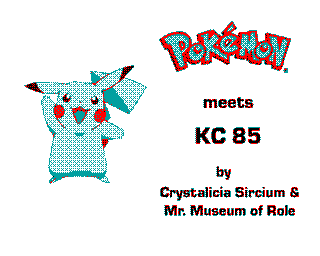- Details
- Geschrieben von Ralf Kästner
- Hauptkategorie: Network
- Veröffentlicht: 17. Mai 2009
- Zugriffe: 59401
Seite 2 von 6
KCNet Project
Because of the long preparatory period, I had enough time to think over a solution. In 2007, the following development goals were defined for the KCNet - Project:
- freely programmable TCP/IP stack without restrictions
- lowest possible memory usage
- low system load through the stack itself
- high stability and reliability
- standalone solution without other computer or server
- low system load through network activity
- high-speed transfer of data between host to host applications
- low response time and a felt fast interface for the user
- universal communication with hosts in- and outside the local network
- easy implementation of standard RFC-protocols
- convenient API for network programming on all layers
- interface-compatibility with as many Z80 systems as possible
- no need for login and/or authentification and a permanent connection for sharing data in the network
The feasibility of the first five goals was an absolute requirement for the start of the project, the rest falls in category "nice to have".
In the last years, it was somewhat quieter about 8-bit computer and TCP/IP, the most known solutions originated predominantly in the time between 1998 and 2002 as the internet became a mass-medium. The connection was done by analog modems over the serial RS-232 interface.
Today, modems are obsolete at home. The ADSL internet is constantly available. A (hardware) router with DSL-modem or cable-modem is the link. Often the router is included for little money or for free as an addition to the provider contract. Such a router manages the internet access data of the provider and connection establishment alone. It contains some important services for easy building of home networks. The entire computer technology behind the router is linked, usually via Ethernet and cable or wlan.
That's why a serial modem connection is not very helpful. What I wanted, was a direct Ethernet access over TCP/IP : the communication standard! This will give me two things in one: access to the ressources of the home network, and universal communication possibilities over the internet. Today, TCP/IP is no more only the standard for the internet communication, but also for the operation of an usual home network with Ethernet.
Beside RS-232 and modem there are other ways and means to implement TCP/IP functionality in a 8-bit system. Below a comparison of other known projects is carried out with the stated aims of the project "KCNet". There are three things to note in particular, if an universal solution should be created for many Z80 systems:
In the last years, it was somewhat quieter about 8-bit computer and TCP/IP, the most known solutions originated predominantly in the time between 1998 and 2002 as the internet became a mass-medium. The connection was done by analog modems over the serial RS-232 interface.
Today, modems are obsolete at home. The ADSL internet is constantly available. A (hardware) router with DSL-modem or cable-modem is the link. Often the router is included for little money or for free as an addition to the provider contract. Such a router manages the internet access data of the provider and connection establishment alone. It contains some important services for easy building of home networks. The entire computer technology behind the router is linked, usually via Ethernet and cable or wlan.
That's why a serial modem connection is not very helpful. What I wanted, was a direct Ethernet access over TCP/IP : the communication standard! This will give me two things in one: access to the ressources of the home network, and universal communication possibilities over the internet. Today, TCP/IP is no more only the standard for the internet communication, but also for the operation of an usual home network with Ethernet.
Beside RS-232 and modem there are other ways and means to implement TCP/IP functionality in a 8-bit system. Below a comparison of other known projects is carried out with the stated aims of the project "KCNet". There are three things to note in particular, if an universal solution should be created for many Z80 systems:
- how the data of the application are handed over to the stack (network API)
- the connection point of the system and TCP/IP-stack layer (network hardware-connection)
- the need and usage of system ressources like memory and I/O space (network driver and/or software)




